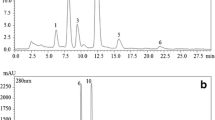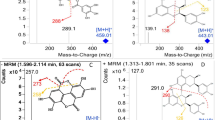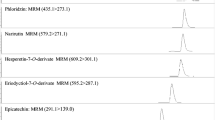Abstract
Pistachio (Pistacia vera L.) belongs to the Anacardiaceae family and it is a small tree species. It is native of the Middle East and Central Asia, but currently, it is cultivated also in California and in some Mediterranean countries, such as Greece and Italy. The most important pistachio producers are Iran, the USA, and Turkey. Besides being a delicious nut, pistachio, due to its wholesome nutritional properties, could be considered as a functional food. According to the results of several studies, pistachios have been proven to have various groups of valuable phytochemicals such as anthocyanins, flavan-3-ols, proanthocyanidins, flavonols, isoflavones, flavanones, stilbenes, and phenolic acids, possessing excellent biological activities. The most common analytical technique employed for their analysis is represented by liquid chromatography coupled to photodiode array and mass spectrometry detection. However, conventional LC can present some limits especially in terms of resolving power. In this contribution, as a powerful alternative, comprehensive two-dimensional liquid chromatography (LC×LC) was applied to the determination of the polyphenolic fraction of pistachio kernels from different geographical origins. A 150-mm micro-bore cyano column (2.7 μm dp) and 50-mm superficially porous C18 silica column (2.7 μm dp) in the first (1D) and second (2D) dimensions were employed, respectively. For boosting orthogonality, a shift 2D gradient was investigated leading to an increase in the overall peak capacity. The newly developed LC×LC method showed satisfactory linearity, sensitivity, precision and accuracy, which was then applied to sample quantitative analysis. A total of 51 different polyphenolic compounds were determined in the four samples investigated and 18 out of them are hereby reported for the first time.



Similar content being viewed by others
References
Göncüoğlu Taş N, Gökmen V. Phenolic compounds in natural and roasted nuts and their skins: a brif review. Curr Opin Food Sci 2017;14:103–109.
Galvano F, Pietri A, Fallico B, Bertuzzi T, Scirè S, Galvano M, et al. Activated carbons: in vitro affinity for aflatoxin B1 and relation of absorption ability to physicochemical parameters. J Food Protect. 1996;59:545–50.
Lau FC, Shukitt-Hale B, Joseph JA. Effect of Concord grape juice on cognitive and motor deficits in aging. Nutrition. 2006;22:295–302.
Agouni A, Lagrue-Lak-Hal AH, Mostefai HA, Tesse A, Mulder P, Rouet P, et al. Red wine polyphenols prevent metabolic and cardiovascular alterations associated with obesity in Zucker fatty rats (Fa/Fa). PLoS One. 2009;4:e5557.
Mazza G. Anthocyanins and heart health. Ann Ist Super Sanità. 2007;43:369–74.
Hou D, Kai K, Li J, Lin S, Terahara N, Wakamatsu M, et al. Anthocyanidins inhibit activator protein 1 activity and cell transformation: structure-activity relationship and molecular mechanisms. Carcinogenesis. 2004;25:29–36.
Wang LS, Stoner GD. Anthocyanins and their role in cancer prevention. Cancer Lett. 2008;269:281–90.
Basu A, Lucas EA. Mechanisms and effects of green tea on cardiovascular health. Nutr Rev. 2007;65:361–75.
Anderson KJ, Teuber SS, Gobeille A, Cremin P, Waterhouse AL, Steinberg FM. Walnut polyphenolics inhibit in vitro human plasma and LDL oxidation. J Nutr. 2001;131:2837–42.
Velayutham P, Babu A, Liu D. Green tea catechins and cardiovascular health: an update. Curr Med Chem. 2008;15:1840–50.
Basaria S, Wisniewski A, Dupree K. Effect of high-dose isoflavones on cognition, quality of life, androgens, and lipoprotein in post-menopausal women. Endocrinol J Invest. 2009;32:150–5.
Tomaino A, Martorana M, Arcoraci T, Monteleone D, Giovinazzo C, Saija A. Antioxidant activity and phenolic profile of pistachio (Pistacia vera L., variety Bronte) seeds and skins. Biochimie. 2010;92:1115–22.
Mandalari G, Bisignano C, Filocamo A, Chessa S, Sarò M, Torre G, et al. Bioaccessibility of pistachio polyphenols, xanthophylls, and tocopherols during simulated human digestion. Nutrition. 2013;29:338–44.
Barreca D, Laganà G, Leuzzi U, Smeriglio A, Trombetta D, Bellocco E. Evaluation of the nutraceutical, antioxidant and cytoprotective properties of ripe pistachio (Pistacia vera L., variety Bronte) hulls. Food Chem. 2016;196:493–502.
Halil Kilic I, Sarikurkcu C, Didem Karagoz I, Uren MC, Sefa Kocak M, Cilkiz M, et al. A significant by-product of the industrial processing of pistachios: shell skin - RP-HPLC analysis, and antioxidant and enzyme inhibitory activities of the methanol extracts of Pistacia vera L.shell skins cultivated in Gaziantep, Turkey. RSC Adv. 2016;6:1203–9.
Erşan S, Güçlü Üstündağ O, Carle R, Schweiggert RM. Identification of phenolic compounds in red and green pistachio (Pistacia vera L.) hulls (Exo- and Mesocarp) by HPLC-DAD-ESI-(HR)-MSn. J Agric Food Chem. 2016;64:5334–44.
Fabani MP, Luna L, Baroni MV, Monferran MV, Ighnai M, Tapia A, et al. Pistachio (Pistacia vera var Kerman) from Argentinean cultivars. A natural product with potential to improve human health. J Funct Food. 2013;5:1347–56.
Rodríguez-Bencomo JJ, Kelebek H, Sonmezdag AS, Rodríguez-Alcalá LM, Fontecha J, Selli S. Characterization of the aroma-active, phenolic, and lipid profiles of the pistachio (Pistacia vera L.) nut as affected by the single and double roasting process. J Agric Food Chem. 2015;63:7830–9.
Gentile C, Tesoriere L, Butera D, Fazzari M, Monastero M, Allegra M, et al. Antioxidant activity of Sicilian pistachio (Pistacia vera L. var. Bronte). J Agric Food Chem. 2007;755:643–8.
Liu Y, Blumberg JB, Oliver Chen C-Y. Quantification and bioaccessibility of California pistachio bioactives. J Agric Food Chem. 2014;62:1550–6.
Sonmezdag AS, Kelebek H, Selli S. Characterization and comparative evaluation of volatile, phenolic and antioxidant properties of pistachio (Pistacia vera L.) hull. J Essent Oil Res. 2017;29:262–70.
Garavand F, Madadlou A, Moini S. Determination of phenolic profile and antioxidant activity of pistachio hull using high-performance liquid chromatography-diode array detector-electro-spray ionization-mass spectrometry as affected by ultrasound and microwave. Int J Food Prop. 2017;20:19–29.
Erşan S, Güçlü Üstündağ O, Carle R, Schweiggert RM. Subcritical water extraction of phenolic and antioxidant constituents from pistachio (Pistacia vera L.) hulls. Food Chem. 2018;253:46–54.
Saitta M, La Torre GL, Potortì AG, Di Bella G, Dugo G. Polyphenols of pistachio (Pistacia vera L.) oil samples and geographical differentiation by principal component analysis. J Am Oil Chem Soc. 2014;91:1595–603.
Ballistreri G, Arena E, Fallico B. Influence of ripeness and drying process on the polyphenols and tocopherols of Pistacia vera L. Molecules. 2009;14:4358–69.
Erşan S, Güçlü Üstündağ O, Carle R, Schweiggert RM. Determination of pistachio (Pistacia vera L.) hull (exo- and mesocarp) phenolics by HPLC-DAD-ESI/MSn and UHPLC-DAD-ELSD after ultrasound-assisted extraction. J Food Comp Anal. 2017;62:103–14.
Erni F, Frei RW. Two-dimensional column liquid chromatographic technique for resolution of complex mixtures. J Cromatogr. 1978;149:561–9.
Hájek T, Škeřiková V, Česla P, Výnhucalová K, Jandera P. Multidimensional LC×LC analysis of phenolic and flavone natural antioxidants with UV-electrochemical coulometric and MS detection. J Sep Sci. 2008;31:3309–28.
Montero L, Sáez V, von Baer D, Cifuentes A, Herrero M. Profiling of Vitis vinifera L. canes (poly)phenolic compounds using comprehensive two-dimensional liquid chromatography. J Chromatogr A. 2018;1536:205–15.
Cacciola F, Delmonte P, Jaworska K, Dugo P, Mondello L, Rader JI. Employing ultra high pressure liquid chromatography as the second dimension in a comprehensive two-dimensional system for analysis of Stevia rebaudiana extracts. J Chromatogr A. 2011;(15):2012–8.
Cacciola F, Donato P, Giuffrida D, Torre G, Dugo P, Mondello L. Ultra high pressure in the second dimension of a comprehensive two-dimensional liquid chromatographic system for carotenoid separation in red chili peppers. J Chromatogr A. 2012;1255:244–51.
Mazzi Leme G, Cacciola F, Donato P, Cavalheiro AJ, Dugo P, Mondello L. Continuous vs segmented second-dimension system gradients for comprehensive two-dimensional liquid chromatography of sugarcane (Saccharum spp.). Anal Bioanal Chem. 2014;406:4315–24.
Donato P, Rigano F, Cacciola F, Schure M, Farnetti S, Russo M, et al. Comprehensive two-dimensional liquid chromatography-tandem mass spectrometry for the simultaneous determination of wine polyphenols and target contaminants. J Chromatogr A. 2016;1458:54–62.
Cacciola F, Mangraviti D, Rigano F, Donato P, Dugo P, Mondello L. Cortes HJ. 2018. Novel comprehensive multidimensional liquid chromatography approach for elucidation of the microbosphere of shikimate-producing Escherichia coli SP1.1/pKD15.071 strain. Anal Bioanal Chem 410:3473–3482.
Wong YF, Cacciola F, Fermas S, Riga S, James D, Manzin V, et al. Untargeted profiling of Glycyrrhiza glabra extract with comprehensive two-dimensional liquid chromatography-mass spectrometry using multi-segmented shift gradients in the second dimension: expanding the metabolic coverage. Electrophoresis. 2018;39:1993–2000.
Willemse CM, Stander MA, Tredoux AGJ, de Villiers A. Comprehensive two-dimensional liquid chromatographic analysis of anthocyanins. J Chromatogr A. 2014;1359:189–201.
Tomasini D, Cacciola F, Rigano F, Sciarrone D, Donato P, Beccaria M, et al. Complementary analytical liquid chromatography methods for the characterization of aqueous phase from pyrolysis of lignocellulosic biomasses. Anal Chem. 2014;86:11255–62.
Sommella E, Ismail OH, Pagano F, Pepe G, Ostacolo C, Mazzoccanti G, et al. Development of an improved online comprehensive hydrophilic interaction chromatography × reversed-phase ultra-high-pressure liquid chromatography platform for complex multiclass polyphenolic sample analysis. J Sep Sci. 2017;40:2188–97.
Sommella E, Pagano F, Salviati E, Chieppa M, Bertamino A, Manfra M, et al. Chemical profiling of bioactive constituents in hop cones and pellets extracts by online comprehensive two-dimensional liquid chromatography with tandem mass spectrometry and direct infusion Fourier transform ion cyclotron resonance mass spectrometry. J Sep Sci. 2018;41:1548–57.
Mandalari G, Tomaino A, Arcoraci T, Martorana M, Lo Turco V, Cacciola F, et al. Characterization of polyphenols, lipids and dietary fibre from almond skins (Amygdalus communis L.). J Food Comp Anal. 2010;23:166–74.
Fanzone M, Zamora F, Jofrè V, Assof M, Pena-Neira A. Phenolic composition of Malbec grape skins and seeds from Valle de Uco (Mendoza, Argentina) during ripening. Effect of cluster thinning. J Agric Food Chem. 2011;59:6120–36.
Perestrelo R, Lu Y, Santos SAO, Silvestre AJD, Neto CP, Camara JS, et al. Phenolic profile of Sercial and Tinta Negra Vitis vinifera L. grape skins by HPLC-DAD-ESI-MSn. Novel phenolic compounds in Vitis vinifera L grape. Food Chem. 2012;135:94–104.
Murphy RE, Schure MR, Foley JP. Effect of sampling rate on resolution in comprehensive two-dimensional liquid chromatography. Anal Chem. 1998;70:1585–94.
Camenzuli M, Schoenmakers PJ. A new measure of orthogonality for multidimensional chromatography. Anal Chim Acta. 2014;838:93–101.
Li X, Stoll DR, Carr PW. Equation for peak capacity estimation in two-dimensional liquid chromatography. Anal Chem. 2009;81:845–50.
Rigano F, Stead S, Mangraviti D, Jandova R, Petit D, Marino N, et al. Use of an “intelligent knife” (iknife), based on the rapid evaporative ionization mass spectrometry technology, for authenticity assessment of pistachio samples. Food Anal Meth. 2018. https://doi.org/10.1007/s12161-018-1386-8.
Elsner V, Wulf V, Wirtz M, Schmitz OJ. Reproducibility of retention time and peak area in comprehensive two-dimensional liquid chromatography. Anal Bioanal Chem. 2015;407:279–84.
Kivilompolo M, Hyotylainen T. Comprehensive two-dimensional liquid chromatography in analysis of Lamiaceae herbs: characterisation and quantification of antioxidant phenolic acids. J Chromatogr A. 2007;1145:155–64.
Acknowledgments
The authors are thankful to Shimadzu and Merck Life Science Corporations for the continuous support.
Funding
This study received financial support from the “Prof. Antonio Imbesi Foundation” of the University of Messina.
Author information
Authors and Affiliations
Corresponding author
Ethics declarations
Conflict of interest
The authors declare that they have no conflict of interest.
Ethical approval
This article does not contain any studies with human participants or animals performed by any of the authors.
Informed consent
Not applicable.
Additional information
Published in the topical collection Young Investigators in (Bio-)Analytical Chemistry with guest editors Erin Baker, Kerstin Leopold, Francesco Ricci, and Wei Wang.
Publisher’s note
Springer Nature remains neutral with regard to jurisdictional claims in published maps and institutional affiliations.
Electronic supplementary material
ESM 1
(PDF 502 kb)
Rights and permissions
About this article
Cite this article
Arena, K., Cacciola, F., Mangraviti, D. et al. Determination of the polyphenolic fraction of Pistacia vera L. kernel extracts by comprehensive two-dimensional liquid chromatography coupled to mass spectrometry detection. Anal Bioanal Chem 411, 4819–4829 (2019). https://doi.org/10.1007/s00216-019-01649-w
Received:
Revised:
Accepted:
Published:
Issue Date:
DOI: https://doi.org/10.1007/s00216-019-01649-w




